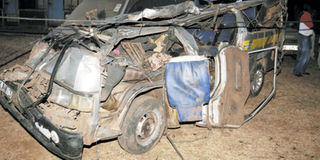140 people killed in road crashes in two weeks

The wreckage of a matatu involved in an accident. Between January 1 and December 20, 2023, some 4,139 people were killed in road accidents, according to the NTSA.
What you need to know:
- According to NTSA, there has been a significant reduction in deaths for all road user groups this year compared to the same period last year.
- Between January 1 and December 20, 2023, some 4,139 people were killed in road accidents, compared to 4,517 in the same period last year.
- The majority of those who lose their lives are vulnerable road users: pedestrians, motorcyclists and cyclists.
One hundred and forty people have lost their lives in road accidents in Kenya in the last two weeks, according to statistics from the National Transport and Safety Authority (NTSA). A closer look at the traffic data as of December 20, 2023 shows that the number of deaths has decreased compared to the same period in 2022.
Between January 1 and December 20, 2023, some 4,139 people were killed in road accidents, compared to 4,517 in the same period last year. This represents a reduction of 8.4%.
According to the latest statistics, there has been a significant reduction in deaths for all road user groups this year compared to the same period last year, with the exception of pedal cyclists.
The increase in cyclist deaths has been attributed to speeding vehicles, dangerous riding, unsafe lane changing, distracted riding and lack of non-motorised transport (NMT) facilities.
Other attributes include the use of mobile phones and other forms of distraction by both motorists and cyclists, failure to wear reflective clothing and the use of NMT facilities intended for cyclists by other road users.
Speaking a fortnight ago, Transport Cabinet Secretary Kipchumba Murkomen said drunk driving, speeding, non-use of seatbelts and helmets and unsafe crossing of the road by pedestrians were major contributors to accidents and injuries.
“People speed due to reasons such as urgency and lateness, which ultimately point to inadequate journey planning and time management. Let us prioritise safety over haste, responsibility over recklessness, and caution over carelessness. Our choices on the road affect not only ourselves but also the lives of others,” Murkomen said at the launch of a road safety campaign called Usalama Barabarani in Nairobi.
He said the campaign would promote safer behaviour by road users and improve the survivability of traffic victims.
The CS further said that the Highway Code provides rules and guidelines on how to use the road.
“All road users – pedestrians, cyclists and motorists – have a right to use the road, but they should always act responsibly to ensure the safety of all. Basic guidelines are given on how to drive, reverse, cross the road as a pedestrian, obey traffic lights and so on.”
Murkomen also said that most accidents, especially in towns and cities, occur on Friday evenings and Monday mornings, with a notable correlation to drunk driving.
“We have seen a troubling trend where private vehicles are engaging in serious driving violations, contributing significantly to the alarming accident rates. Unfortunately, these incidents are not only tragic losses but also detrimental to the economy,” the CS said.
Murkomen further noted that most motorists are either unaware of the risks associated with reckless driving, or they are deliberately engaging in bad practices that endanger their own lives and those of other road users.
“We have situations where passengers observe the driver sleeping or speeding. Instead of passengers speaking out against such behaviour, they choose to record it. It is the passengers who [need to] report these things, and when they do, we take action,” he said.
According to the World Health Organization’s Global Status Report on Road Safety, between 3,000 and 13,000 Kenyans lose their lives in road traffic crashes every year.
The majority of these people are vulnerable road users: pedestrians, motorcyclists and cyclists. In addition, almost a third of the deaths are passengers – many of whom die on unsafe public transport.





